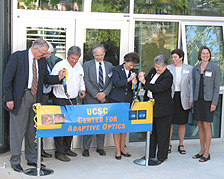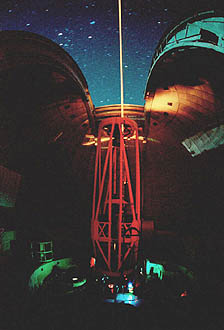|
      
|
June 24, 2002
NSF Director Rita Colwell helps dedicate the Center for Adaptive Optics
By Tim Stephens
Rita Colwell, director of the National Science Foundation (NSF), visited UCSC last
week for the dedication of the NSF-funded Center for Adaptive Optics. During her
visit, Colwell also met with faculty and students, toured the campus, and gave a
speech on "NSF's Investment in Converging Frontiers."
Adaptive
optics ushers in a new era in ground-based astronomy
Adaptive
optics technology provides powerful tools for eye doctors |
 |
| At the ribbon-cutting, left to right, are C. Judson King, senior vice president,
UCOP; (partially hidden: Chris Le Maistre, CfAO managing director); Jerry Nelson,
CfAO director; Morris Aizenman, NSF program director; Rita Colwell, NSF director;
Chancellor M.R.C. Greenwood; Claire Max, CfAO associate director; Lisa Hunter, CfAO
associate director. Photo: Tim Stephens |
 |
| This photo shows the laser beam from inside the dome of the Shane Telescope at
Lick Observatory. Photo: Laurie Hatch, Lick Observatory |
Colwell said she often cites adaptive optics as an excellent example of interdisciplinary
science when she gives talks around the country and abroad.
"Fundamental research to create a clearer view of the universe has spawned a
new technology for the study of the human eye that could potentially benefit everyone.
That's what I call a great return on our investment," Colwell said.
The multi-institutional Center for Adaptive Optics, headquartered at UCSC, was
established in 1999 as an NSF Science and Technology Center focused on the advancement
and application of adaptive optics technology.
Adaptive optics (AO) is used in astronomy and vision science to correct the blurring
of images caused when light travels through a distorting medium. For example, turbulence
in the Earth's atmosphere limits how clearly astronomers can see stars and other
objects with even the largest ground-based telescopes. Similarly, internal imperfections
and fluids in the eye not only affect vision but also limit the ability of doctors
to get a clear view of the retina to diagnose and correct retinal defects and disease.
"In astronomy, adaptive optics can remove much of the blurring caused by the
atmosphere, giving us the sharpest images ever obtained with ground-based telescopes.
We are also seeing some major advances in vision science through the use of adaptive
optics, and we expect to see new ophthalmic instrumentation developed in the near
future," said Jerry Nelson, director of the Center for Adaptive Optics and a
professor of astronomy and astrophysics at UCSC. "But there are still significant
technical challenges to overcome before we can realize the full potential of this
technology," he added.
At the dedication on Friday, June 21, the Center for Adaptive Optics (CfAO) celebrated
recent progress in adaptive optics research and the completion of a new headquarters
building on the UCSC campus. The 4,000-square-foot building on Science Hill provides
offices and meeting space for faculty, visiting scientists, students, and administrators.
Andrea Ghez, an associate director of the CfAO and professor of astronomy and physics
at UCLA, spoke at the dedication on adaptive optics applications in astronomy. Austin
Roorda, assistant professor of optics at the University of Houston's College of Optometry,
discussed adaptive optics applications in vision science. Lisa Hunter, CfAO associate
director of education and human resources, discussed the center's education and outreach
programs.
The Center for Adaptive Optics is funded by a $20 million, five-year grant from NSF,
which is extendable for an additional five years of funding at the same level. The
NSF is the single largest source of funding for research at UC Santa Cruz, currently
supporting 153 active projects with total annual funding of approximately $19 million.
The Center for Adaptive Optics has 27 partner institutions, including universities,
national laboratories, industry partners, and international collaborators. Five UC
campuses, the California Institute of Technology, University of Chicago, University
of Houston, University of Rochester, Indiana University, and the Lawrence Livermore
National Laboratory (LLNL) are among the top institutions advancing the science and
technology behind adaptive optics. Industry partners such as Bausch & Lomb and
Lucent Technologies are working with the center to develop practical new devices
and implement AO applications in health care and other fields.
Rita Colwell has been director of the NSF since 1998. She has spearheaded the agency's
emphases in K-12 science and mathematics education, graduate science and engineering
education and training, and increased participation of women and minorities in science
and engineering. Under Colwell's leadership, the agency has supported major new initiatives
in the areas of nanotechnology, biocomplexity, information technology, and the 21st
century workforce.
Before taking the helm at NSF, Colwell was president of the University of Maryland
Biotechnology Institute and professor of microbiology at the University of Maryland.
She holds a B.S. in bacteriology and an M.S. in genetics from Purdue University,
and a Ph.D. in oceanography from the University of Washington.
Return to Front Page 
|
 |